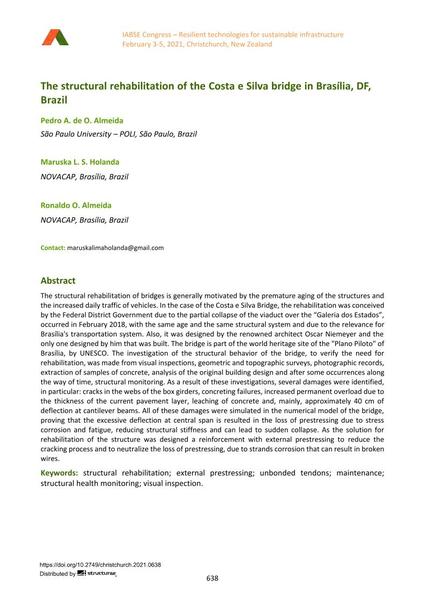The structural rehabilitation of the Costa e Silva bridge in Brasília, DF, Brazil

|
|
|||||||||||
Bibliografische Angaben
| Autor(en): |
Pedro Almeida
(São Paulo University – POLI, São Paulo, Brazil)
Maruska L. S. Holanda (NOVACAP, Brasília, Brazil) Ronaldo O. Almeida (NOVACAP, Brasília, Brazil) |
||||
|---|---|---|---|---|---|
| Medium: | Tagungsbeitrag | ||||
| Sprache(n): | Englisch | ||||
| Tagung: | IABSE Congress: Resilient technologies for sustainable infrastructure, Christchurch, New Zealand, 3-5 February 2021 | ||||
| Veröffentlicht in: | IABSE Congress Christchurch 2020 | ||||
|
|||||
| Seite(n): | 638-646 | ||||
| Anzahl der Seiten (im PDF): | 9 | ||||
| DOI: | 10.2749/christchurch.2021.0638 | ||||
| Abstrakt: |
The structural rehabilitation of bridges is generally motivated by the premature aging of the structures and the increased daily traffic of vehicles. In the case of the Costa e Silva Bridge, the rehabilitation was conceived by the Federal District Government due to the partial collapse of the viaduct over the “Galeria dos Estados”, occurred in February 2018, with the same age and the same structural system and due to the relevance for Brasília's transportation system. Also, it was designed by the renowned architect Oscar Niemeyer and the only one designed by him that was built. The bridge is part of the world heritage site of the "Plano Piloto" of Brasília, by UNESCO. The investigation of the structural behavior of the bridge, to verify the need for rehabilitation, was made from visual inspections, geometric and topographic surveys, photographic records, extraction of samples of concrete, analysis of the original building design and after some occurrences along the way of time, structural monitoring. As a result of these investigations, several damages were identified, in particular: cracks in the webs of the box girders, concreting failures, increased permanent overload due to the thickness of the current pavement layer, leaching of concrete and, mainly, approximately 40 cm of deflection at cantilever beams. All of these damages were simulated in the numerical model of the bridge, proving that the excessive deflection at central span is resulted in the loss of prestressing due to stress corrosion and fatigue, reducing structural stiffness and can lead to sudden collapse. As the solution for rehabilitation of the structure was designed a reinforcement with external prestressing to reduce the cracking process and to neutralize the loss of prestressing, due to strands corrosion that can result in broken wires. |
||||
| Stichwörter: |
externe Vorspannung Wartung Sichtprüfung
|
||||
